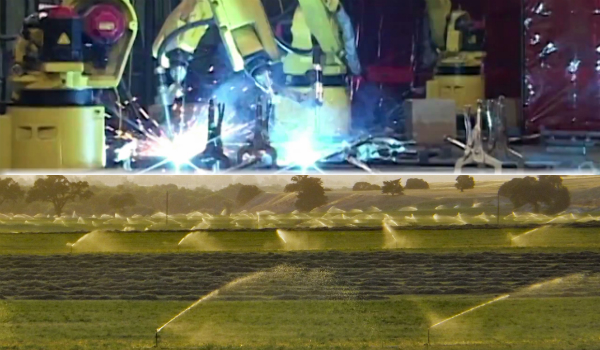
(Farm Photo Credit: Ken Figlioli/Flickr)
Two big parts of California’s very diverse economy were getting attention this week.
The impact of the extreme drought is spanking one of our most important industries and largest user of water: agriculture.
According to a UC Davis report, the state has lost over $800 million in crop loss. But it could be worse. The state’s farmers have spent $500 million to pump groundwater in sustaining many of our crops.
But that’s not a long-term solution. If the drought keeps going, pulling groundwater next year and the year after would put California is a very dangerous spot.
In fact, the report says: “Failure to replenish groundwater in wet years will continue to reduce groundwater availability to sustain agriculture during California’s frequent droughts.”
Which makes the California Economic Summit plan to respond to the drought so relevant to what the UC Davis researchers have concluded. The state needs to be looking downstream.
Emergency measures and long-term water projects, including those related to groundwater management, should be comprehensive and integrated with other water needs, and have incentives for strategies that produce some clear results.
Along the lines of the report’s suggestion of enhancing California’s water trade market, one of the Summit ideas includes streamlining the regulations around water transfers, which sometimes can take several months and many signatures to get approved.
As the water bond debate picks up steam again and the drought drags on, it’s imperative that California not manage watersheds, storm water, groundwater aquifers, and water supply systems as separate issues anymore, but does promote projects that protect the environment, support regional economies, and increase opportunities for all Californians at the same time.
To read the full story, click over to caeconomy.org/reporting.
In the manufacturing sector, the story is a little difference. We haven’t had been able to pump any figurative manufacturing groundwater to stem what have been serious losses—about 840,000 jobs have evaporated in the state since 1990,
You can read about it in this report issued by the Los Angeles Economic Development Corporation.
The silver lining in this report is that California’s manufacturing sector is the still the largest of any state–and there appears to be seem some positive momentum.
As the LAEDC report indicates, a major part of keeping and capturing manufacturing employment in California is making sure that the workforce is trained for the increasingly complex manufacturing jobs that are available.
Technology has played a huge role in advancing manufacturing.
“It means that productivity is soaring but employment is not, so we continue to lose employment in manufacturing jobs while our output and the value of our output keep increasing,” said Christine Cooper, who co-authored the study.
Here’s the complete story on caeconomy.org/reporting.
The California Economic Summit Action Teams have been working on manufacturing, water, workforce development and other key elements of the Golden State’s economy.
The Summit, which is a project of California Forward and the California Stewardship Network, will hold is 2014 meeting in Sacramento on August 12.

